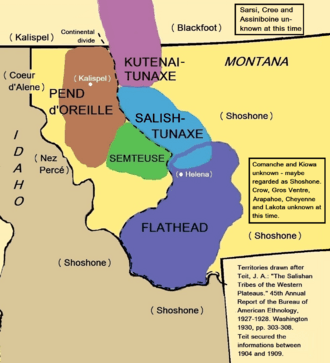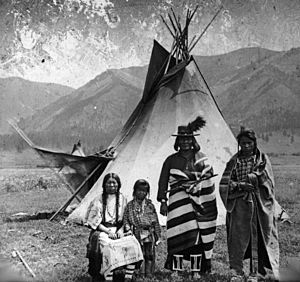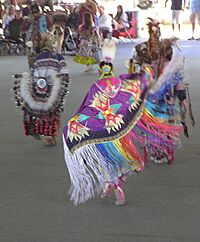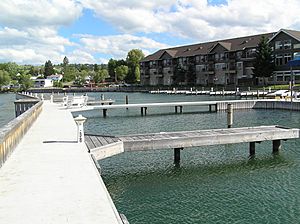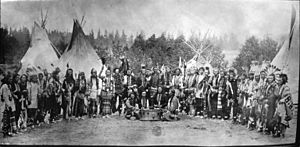Confederated Salish and Kootenai Tribes facts for kids
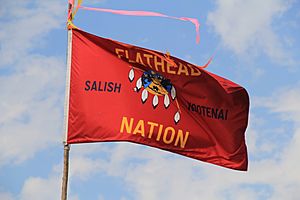
The Confederated Salish and Kootenai Tribes (CSKT) of the Flathead Reservation are a group of Native American tribes. They are officially recognized by the U.S. government. These tribes live in the state of Montana. Their government includes members from the Bitterroot Salish, Kootenai, and Pend d'Oreilles tribes. Most members live on the Flathead Indian Reservation.
European travelers gave these people the name "Flathead Indians." This was because the heads of the Salish peoples were naturally flatter than those of some other nearby tribes.
Contents
Early Life of the Salish People
The early Salish, also known as Flatheads, lived east of the Continental Divide. This is a line of mountains that separates rivers flowing to the Pacific from those flowing to the Atlantic. They set up their main camps near the eastern side of the Rocky Mountains. Sometimes, they hunted in the mountains. However, they did not go west of the Bitterroot Range.
Two tribes lived north of the Flatheads: the Salis-Tunaxe and the Kutenai-Tunaxe (Kootenai-Tunaxe). They both shared a common enemy, the Blackfoot tribes. The Pend d'Oreille lived around Flathead Lake, which is west of the Rocky Mountains. The Semteuse lived in a small area south of the Pend d'Oreille. The Shoshone tribe surrounded the Salish from the northeast to the southwest.
How Horses Changed Their Lives
After the Salish got horses from the Shoshone, their hunting and homes changed a lot. Horses allowed the Salish to hunt the American bison (buffalo) for meat and skins. Before they had many bison skins, the women wove tule mats. They used these mats in layers to cover cone-shaped tents. After getting more bison, the tipi made from animal hides replaced these older homes.
Moving West of the Mountains
The Blackfoot and a disease called smallpox almost wiped out the Salish-Tunaxe and Semteuse tribes. Some survivors found refuge (safety) among the Salish. Between 1700 and 1750, Blackfoot warriors forced the Salish and the Kutenai-Tunaxe out of the bison hunting areas. They had to move west of the Continental Divide.
History of the Tribes
The first written record of these tribes is from the Lewis and Clark Expedition. This was on September 4, 1805. At that time, the Flatheads lived between the Cascade Range and Rocky Mountains. The Flatheads also appear in the records of the Catholic Church in St. Louis, Missouri, and Sula, Montana.
The Hellgate Treaty
The tribes signed the Hellgate treaty with the United States in 1855. From the very beginning, there was confusion. This was because of problems with translation. The tribal people thought they were making a formal friendship agreement. The non-tribal people wanted to claim Native land and resources.
Isaac Stevens, the new governor of the Washington Territory, wanted to own the Bitterroot Valley. He also wanted more than 20 million acres (81,000 square kilometers) of land from the Salish. Chief Victor (Many Horses) put his "X" mark on the document. He believed the agreement would not make his people leave their homeland. The Salish did not find out until 15 years later that the Bitterroot Valley was no longer theirs.
Forced Relocation
The 1864 gold rush brought more settlers and government attention to the Montana Territory. Chief Victor died in 1870. His son, Chief Charlot (also known as Charlo), became the new chief. In 1871, President Ulysses S. Grant issued an executive order. This order said the Jocko (Flathead) Reservation was a better place for the Salish to live.
When Congressman James A. Garfield arrived in 1872 to move the Salish people, Charlot ignored the order. He even ignored threats of violence. U.S. officials then faked Charlot's "X" mark on the agreement. This fake document was sent to the Senate.
In the late 1880s, the U.S. built the Missoula and Bitter Root Valley Railroad. It went directly through the tribe's lands. They did this without asking permission or paying the Native owners. In October 1891, soldiers from Fort Missoula forced Charlot and the Salish out of the Bitterroot Valley. They roughly marched the small group 60 miles to the Flathead Reservation. The three main tribes moved to the Flathead Reservation were the Bitterroot Salish, the Pend d'Oreille, and the Kootenai. The Bitterroot Salish and the Pend d'Oreille tribes spoke similar languages.
Protecting Their Identity
The U.S. federal government had a policy called House concurrent resolution 108. This policy started a process to stop recognizing the Flatheads as tribes. This was called the "Indian termination policy." The Flathead Tribes fought against the government's plans to end their tribal relationship. They spoke out in Congressional hearings in 1954.
Who Lives on the Reservation?
As of 2013, the tribe has about 6,800 members. About 4,000 tribal members live on the Flathead Reservation. Another 2,800 tribal members live off the reservation. About 1,100 Native Americans from other tribes also live there. More than 10,000 non-Native Americans also live on the reservation.
Their main religion is Roman Catholicism.
How the Tribes Make Money
The tribes are the biggest employers on the reservation. In 2011, they provided 65% of all jobs.
The tribes are the first Native American nation in the United States to own a hydroelectric dam. This dam is called the Séliš Ksanka Ql'ispé Dam. They also own and run other businesses. These include Mission Valley Power, which is the only local electricity provider. They also own S&K Electronics, S&K Technologies, the KwaTaqNuk Resort & Casino, and Gray Wolf Peak Casino.

Where They Lived
Original Lands
The people of these tribes originally lived in areas of Montana, parts of Idaho, British Columbia (Canada), and Wyoming. Their original territory was about 22 million acres (89,000 square kilometers). This was at the time of the 1855 Hellgate treaty.
Reservation Lands
The Flathead Reservation is in northwest Montana. It is over 1.3 million acres (5,300 square kilometers) in size.
The Tribal Council represents eight districts on the reservation:
- Arlee District
- Dixon District
- Elmo District
- Hot Springs District
- Pablo District
- Polson District
- Ronan District
- St. Ignatius District
During World War II, a large ship was named the SS Chief Charlot. It was a 422-foot (129 m) Liberty Ship. It was built in Richmond, California, in 1943, to honor Chief Charlot.
Culture and Traditions
The tribes have rich cultural traditions. They speak different languages:
They also have many important historical sites and archaeological areas.
Notable People
- Corwin Clairmont, artist and educator
- Marvin Camel, boxer, WBC & IBF Cruiserweight Champion
- Debra Magpie Earling, author
- Terese Marie Mailhot, author
- D'Arcy McNickle (1904 – 1977), a famous writer, Native American activist, and anthropologist
- Jaune Quick-to-See Smith, artist
Interesting Facts About the Confederated Salish and Kootenai Tribes
- In the spring, the Salish would gather roots, vegetables, and medicines. These would last them for the entire year.
- In the summer, as berries and other fruits became ripe, they would gather them too.
- During the fall, the Salish would hunt for meat. This meat would then be dried for the winter months.
- The Flathead reservation is home to 65% of enrolled Flathead tribal members.
- Land owned by the Salish used to stretch from Montana all the way to the Pacific Coast.
- The Salish call themselves "Sqelixw." The Kootenai call themselves "Ktunaxa." The Pend d'Oreille call themselves "Qæispé."
- The Salish made bows from hardwood. They gathered this wood in very early spring. They made bow strings from twisted sinew (animal tissue).
- The Salish Longhouse is a very important center of tribal cultural life.
- The Kootenai were divided into two main groups. One group lived to the northeast and hunted bison. The other group lived in the mountainous west and focused on rivers and lakes.
- Every year in July, the Flathead reservation celebrates the Standing Arrow Pow Wow and the Arlee Pow Wow.
See also
 In Spanish: Tribus confederadas salish y kutenai de la nación flathead para niños
In Spanish: Tribus confederadas salish y kutenai de la nación flathead para niños



